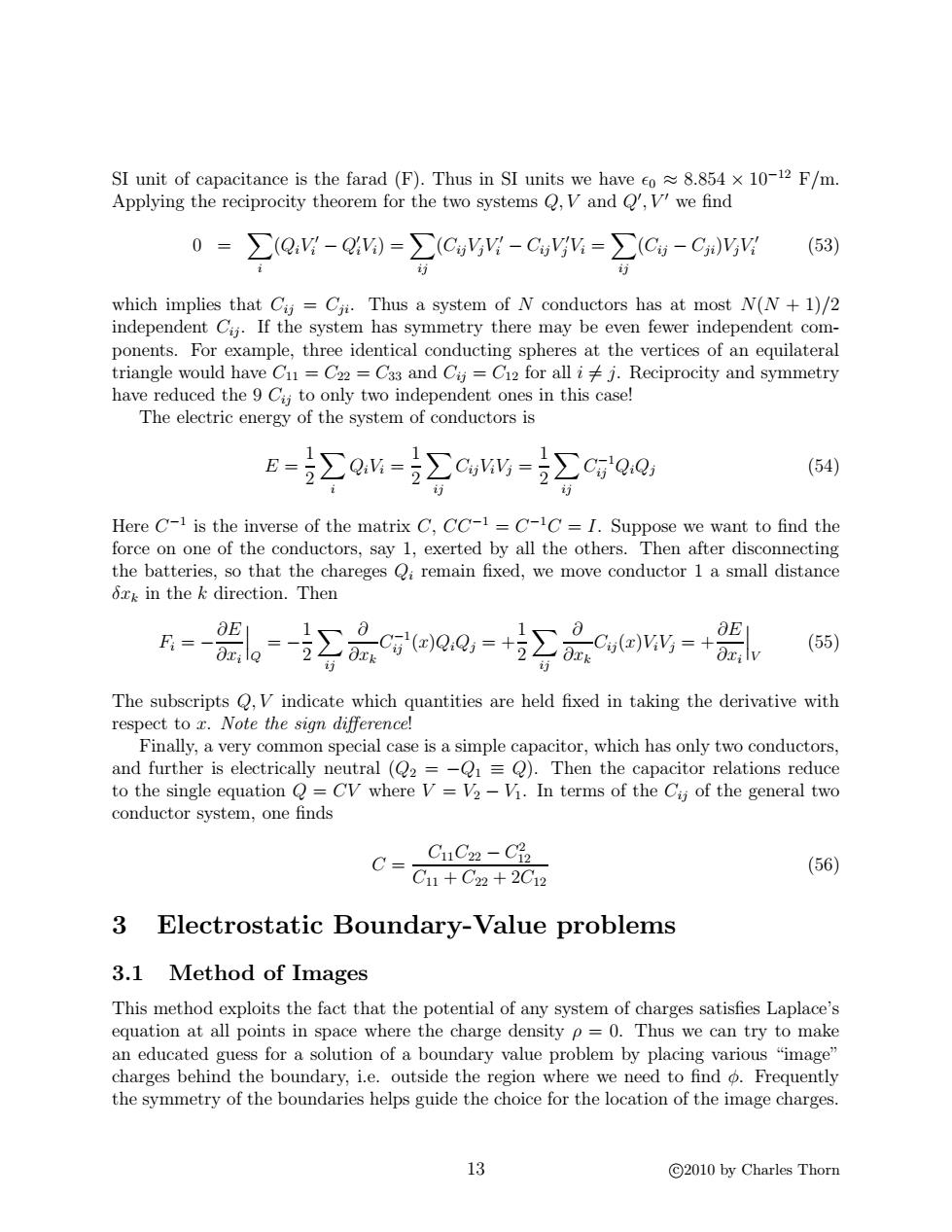正在加载图片...

SI unit of capacitance is the farad (F).Thus in SI units we have o8.854 x 10-12 F/m. Applying the reciprocity theorem for the two systems Q,V and Q,V we find 0=∑(QY-Qw)=∑(CyYW-Cy%=∑(C,-C)ygg (53) which implies that Cii Cii.Thus a system of N conductors has at most N(N+1)/2 independent Cii.If the system has symmetry there may be even fewer independent com- ponents.For example,three identical conducting spheres at the vertices of an equilateral triangle would have C1=C22=C33 and Cii =C12 for all ij.Reciprocity and symmetry have reduced the 9 Ci;to only two independent ones in this case! The electric energy of the system of conductors is E=∑Q%=∑c%=∑c写Q.Q, (54) Here C-1 is the inverse of the matrix C,CC-1=C-1C=I.Suppose we want to find the force on one of the conductors,say 1,exerted by all the others.Then after disconnecting the batteries,so that the chareges Qi remain fixed,we move conductor 1 a small distance OZk in the k direction.Then =9盟。=-∑品co.,=+号∑品cy=+ E (55) The subscripts V indicate which quantities are held fixed in taking the derivative with respect to r.Note the sign difference! Finally,a very common special case is a simple capacitor,which has only two conductors, and further is electrically neutral (Q2=-Q1=Q).Then the capacitor relations reduce to the single equation =CV where V=V2-Vi.In terms of the Ci of the general two conductor system,one finds C11C22-Ci2 C=Cu+Ca+2C1 (56) 3 Electrostatic Boundary-Value problems 3.1 Method of Images This method exploits the fact that the potential of any system of charges satisfies Laplace's equation at all points in space where the charge density p=0.Thus we can try to make an educated guess for a solution of a boundary value problem by placing various "image" charges behind the boundary,i.e.outside the region where we need to find o.Frequently the symmetry of the boundaries helps guide the choice for the location of the image charges. 13 ©2010 by Charles ThornSI unit of capacitance is the farad (F). Thus in SI units we have 0 ≈ 8.854 × 10−12 F/m. Applying the reciprocity theorem for the two systems Q, V and Q0 , V 0 we find 0 = X i (QiV 0 i − Q 0 iVi) = X ij (CijVjV 0 i − CijV 0 j Vi = X ij (Cij − Cji)VjV 0 i (53) which implies that Cij = Cji . Thus a system of N conductors has at most N(N + 1)/2 independent Cij . If the system has symmetry there may be even fewer independent components. For example, three identical conducting spheres at the vertices of an equilateral triangle would have C11 = C22 = C33 and Cij = C12 for all i 6= j. Reciprocity and symmetry have reduced the 9 Cij to only two independent ones in this case! The electric energy of the system of conductors is E = 1 2 X i QiVi = 1 2 X ij CijViVj = 1 2 X ij C −1 ij QiQj (54) Here C −1 is the inverse of the matrix C, CC −1 = C −1C = I. Suppose we want to find the force on one of the conductors, say 1, exerted by all the others. Then after disconnecting the batteries, so that the chareges Qi remain fixed, we move conductor 1 a small distance δxk in the k direction. Then Fi = − ∂E ∂xi
Q = − 1 2 X ij ∂ ∂xk C −1 ij (x)QiQj = + 1 2 X ij ∂ ∂xk Cij (x)ViVj = + ∂E ∂xi
V (55) The subscripts Q, V indicate which quantities are held fixed in taking the derivative with respect to x. Note the sign difference! Finally, a very common special case is a simple capacitor, which has only two conductors, and further is electrically neutral (Q2 = −Q1 ≡ Q). Then the capacitor relations reduce to the single equation Q = CV where V = V2 − V1. In terms of the Cij of the general two conductor system, one finds C = C11C22 − C 2 12 C11 + C22 + 2C12 (56) 3 Electrostatic Boundary-Value problems 3.1 Method of Images This method exploits the fact that the potential of any system of charges satisfies Laplace’s equation at all points in space where the charge density ρ = 0. Thus we can try to make an educated guess for a solution of a boundary value problem by placing various “image” charges behind the boundary, i.e. outside the region where we need to find φ. Frequently the symmetry of the boundaries helps guide the choice for the location of the image charges. 13 c 2010 by Charles Thorn